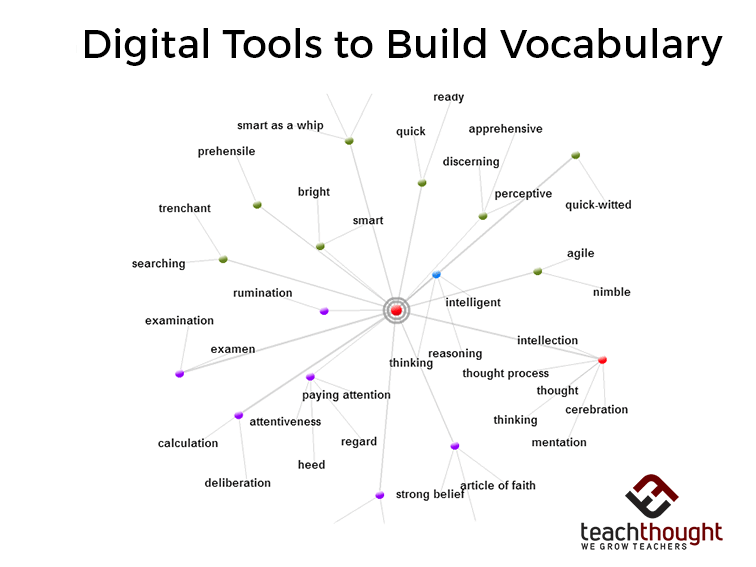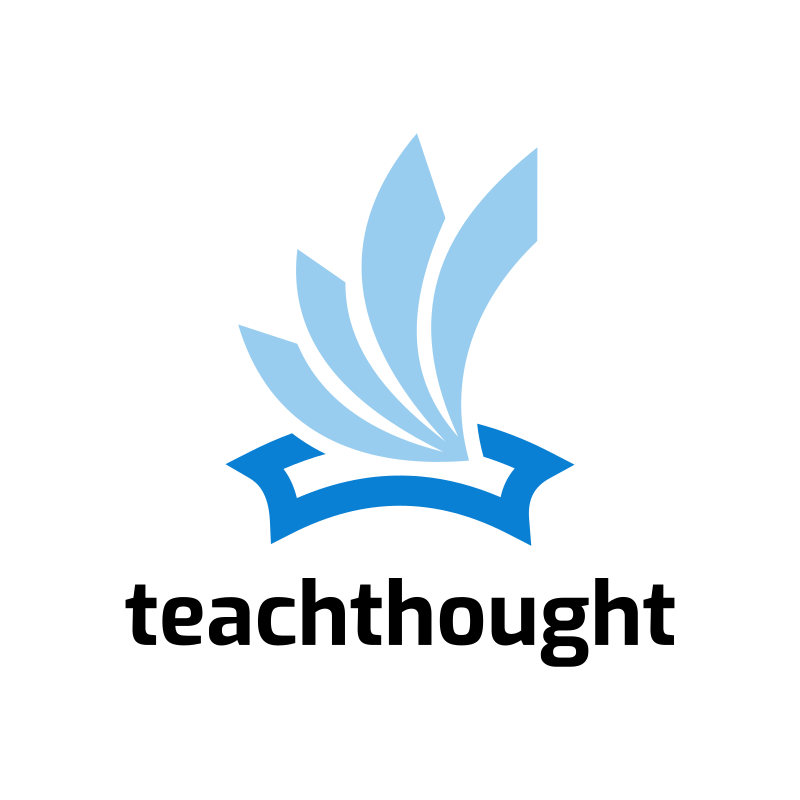
Build Vocabulary With These Digital Tools
by Kimberly Tyson, Ph.D and TeachThought Staff
Vocabulary influences fluency, comprehension, and student achievement. How’s that for starters?
In addition, a broad vocabulary is important for effective speaking, listening, reading, and writing. Vocabulary is a foundational component of an effective K-12 comprehensive literacy framework. And, vocabulary plays an important role in most academic standards.
I write frequently about the importance of effective vocabulary instruction and my recent infographic – the 10 Do’s and Don’ts of Effective Vocabulary Instruction. Since a broad vocabulary program includes both direct and indirect word-learning strategies, the following online tools can be easily integrated to support word learning.
In today’s 21st century classrooms, digital tools must coexist alongside more traditional tools. Online tools, compared to their more traditional counterparts, provide a broader array of information about words and word meanings. In addition, some tools allow teachers to easily customize words so that students can practice, review, and play games with content or unit-specific words.
See also 25 Ways Schools Can Promote Literacy And Independent Thinking
Digital tools have advantages. For example, many allow students to:
hear pronunciations;
read words in a variety of authentic examples;
view photos and images related to words (important for English language learners);
reinforce word learning through interactive games;
play with and manipulate language;
discover rhyming words; and
collaborate with classmates to create virtual words walls.
The following digital tools show promise to support word learning, review, and playing with language. I’ve grouped these tools into four categories: Reference Tools, Word Clouds, Games and Review, Word Walls and Virtual Field Trips. They’re not listed in any particular order, so check out the entire list. Like other digital tools, they’re not all created equal. Choose tools carefully to support standards and learning goals.
24 Digital Tools to Build Vocabulary
Reference Tools
1. Collocation Dictionary
According to their description, the Collocation Dictionary is “a completely new type of dictionary with word collocation that helps students and advanced learners effectively study, write, and speak natural-sounding English.”
2. Lexipedia
Looking for a visual thesaurus? Then Lexipedia is for you. Simple to use. Just type in any word and Lexipedia instantly displays the target word along with other words. It also color-codes the words by both parts of speech and relationships. As you hover over a word, a complete definition is displayed.
3. Snappy Words
Similar to Lexipedia, Snappy Words is another visual thesaurus. Teachers may want to introduce several of the thesaurus tools and allow students to select which works best for them. The visually sparse, cleaner display of Lexipedia works better for me.
5. Visuwords
6. Word Hippo
An all-in-one reference tool, Word Hippo does the following: defines a word, provides a meaning, provides a word that is opposite, pronounces a word, provides rhyming words, places the word in many different contexts, and translates the word. Whew! That’s a lot.
7. Wordnik.com
Wordnik has the look and feel of a traditional dictionary with a twist. Along with the definition, students can see images related to the word, hear related sounds, and even see tweets with the target word highlighted. The ‘related words’ feature is particularly helpful. Wordnik also features a ‘Word of the Day,’ ‘Random Words,’ and pronunciations of words.
Your Dictionary bills itself as providing simple, straightforward definitions and the easiest-to-use online dictionary. That’s about right. Sometimes simple is good. In addition to providing a definition, Your Dictionary also includes a thesaurus and places the word in varied sentence examples.
9. MathWords
Math Words is a simple-to-use online dictionary specifically for math terms and formulas. This dictionary appears most appropriate for intermediate and secondary students.
10. A Math Dictionary for Kids
A kid-friendly math dictionary. I like the simple, bright appearance that includes visual examples of each term. This math dictionary seems to be appropriate for elementary students.
11. Vocabulary.com
12. Magoosh Vocab
Word Clouds
13. Wordle
Type (or copy & paste) in a chunk of text or individual words and Wordle generates a word cloud of the key vocabulary based on word frequency. Wordle can also be used for many varied purposes – check out these 52 ideas for using Wordle to support learning.
14. WordSift
Similar to Wordle, students type (or copy & paste) in a piece of text and WordSift sorts the text based on word frequency. The visual thesaurus that displays beneath the words is a nice addition in WordSift. With the visual thesaurus, students immediately see how words are grouped semantically. A useful addition, I think.
15. WordVis
16. Quizlet
17. Knowji (a series of apps contextual vocabulary-learning apps separated by relative grade and reading-level)
18. Lingro
Lingro is a cool tool for both the ‘wow’ factor and for its usefulness. Simply type in a website address on the Lingro website and it instantly turns the website into a clickable dictionary that translates text in 12 languages. Lingro hides in the background until students need it. To use, students simply click on any word and several definitions of the word are instantly displayed. I could see this as very useful tool for just-in-time support for English language learners.
See Also Building Academic Vocabulary Using Marzano’s 6-Step Process
Games and Review
19. Vocabulary Spelling City
A beefed-up version of vocabulary games, Vocabulary Spelling City includes many more game-like activities useful for reviewing words. A number of teacher-made lists are included such as analogies, compound words, math words, and many more. The free version seems to include about 5 activities and teachers can save lists. ‘Teach Me’ pronounces words and uses each word in context.
Teachers can use pre-selected sentences or create their own. Vocabulary Spelling City is a useful tool for students, teachers, and parents. While there is both a free and paid version, Vocabulary Spelling City seems like a natural for PTA funding. The classroom paid version allows students to practice in school and at home as well.
20. Vocab Genius
21. Free Rice
At Free Rice, students can practice matching words to the correct definition, and donate rice at the same time. For each correct answer, the United Nations World Food Programme donates 10 grains of rice to a country in need. How’s that for combining word learning with social goodness? When a student plays, there is a visual display of rice (see image) which is added to a bowl each time the student makes a correct response. Free Rice includes subject area lists in Geography, Science, Math, and others. It is leveled so students can play at just the right level of challenge for them.
Note of caution: Free Rice may be addicting to you and your students.
Word Walls & Virtual Field Trips
22. Padlet
Padlet is an online space to create a collaborative, digital word wall. Getting a leg up on the more traditional word wall, Padlet allows users to create sticky notes that can include text, images, links, and videos. Teachers can embed this into a classroom website or blog which makes it a go-to collaborative space for students. For primary students, teachers will probably want to create the wall with words and links for students. Older students will get the hang of it fairly quickly. A great, collaborative tool and virtual classroom space to build online references and key vocabulary for content units.
23. ThingLink
ThingLink is a tool for making images interactive. To use, simply upload an image, identify hot spots on specific parts of the image, and add text or web links to the image. In the classroom, teachers could use ThingLink to launch a unit by introducing students to key vocabulary or students could design interactive images as they become more familiar with vocabulary. There are many possibilities; I’d love to know how you use ThingLink to extend and deepen student learning.
24. TrackStar
TrackStar, a free online program, allows teachers to collect a series of websites and annotate them so that students can follow an online journey. With a little work, teachers can create a visual vocabulary field trip for students. Teachers determine topics that support units of study. TrackStar is a great way for students to experience multiple exposures to words in varied contexts (a characteristic of effective vocabulary instruction).
More Of The Best Vocabulary Tools
